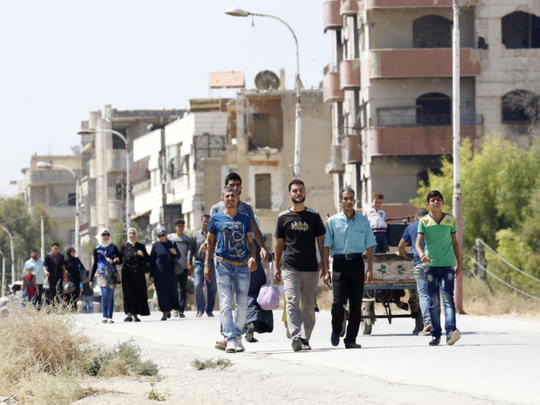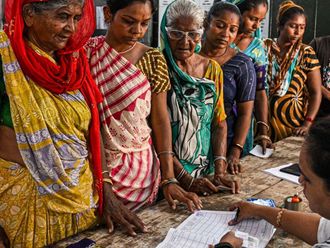
After more than four years of stiff resistance, the people of Daraya, the legendary western suburb of the Syrian capital Damascus, have decided to give up. Opposition factions in the city agreed to evacuate with their families and light weapons. The Syrian regime celebrated the settlement as a great victory, wherein President Bashar Al Assad performed the Eid prayer at what was left of Daraya’s grand mosque.
At the beginning of the Syrian revolution in 2011, Daraya led the peaceful protest movement outside the capital; and went on to become a model for disciplined civilian action. Yet, heavy-handed approach by the army and security services forced the people of Daraya into carrying arms to defend themselves.
For four years, regime forces tried to retake the city, but could not. Since the Russian military intervention in September 2015, regime forces intensified their efforts to subjugate the area and its people. According to Daraya’s local council, an opposition institutional body that was set up to administer the city, more than 9,000 barrel bombs were dropped on Darayya until August 23, 2016, causing hundreds of civilian deaths and large-scale destruction. Nevertheless, regime forces could only advance into the city in recent months because of Russian air and intelligence support. In early 2016, regime forces succeeded in cutting the vital geographical link between Daraya and the neighbouring town of Muadamiya. That link ensured the minimum food and medicine supplies required for the survival of opposition fighters inside Daraya.
The Syrian regime tried unsuccessfully to have Daraya excluded from the ceasefire agreement brokered by Russia and the United States at the end of February 2016, ahead of the Geneva 3 talks, claiming that the city played host to extremist elements. However, the regime did succeed in preventing humanitarian relief supplies from reaching the city and the United Nations was only able to send in one humanitarian convoy to Daraya during the five-month ceasefire agreement.
With the faltering of Geneva 3 talks and the gradual breakdown of ceasefire, regime assault on Daraya has resumed. The territories controlled by opposition factions shrank to merely 1.5 square kilometres. Most of the opposition-held agricultural land — the sole source of food supplies — was destroyed when the regime used napalm to bomb the city. Pressure on armed opposition factions to negotiate a deal to ensure a safe exit for the civilian population mounted henceforth.
Negotiations between the local council of Daraya city and a regime delegation commenced early last month. The regime demanded a complete surrender, including the raising of a white flag. Daraya refused to do so and instead insisted on an appropriate safe-exit agreement for civilians and fighters. Opposition factions agreed to hand over their heavy but not the light weapons. An agreement was reached, whereby fighters who refused amnesty were given safe passage to Idlib, while civilians were transported to other nearby places around Damascus.
The strategic location of Daraya was not the only reason for the regime to accept the terms of the opposition to evacuate the city. Given the symbolic value of Daraya as a bastion of resistance, the regime’s key objective was to put an end to a legend. Indeed, the evacuation of the city was a big blow to the morale of the revolution, for which Daraya had become an icon.
Henceforth, the regime immediately started exploiting the end of the conflict in Daraya to impose its will on other rebel-held areas. A similar agreement; but with harsher conditions, was therefore offered to the neighbouring city of Muadamiya.
The removal of opposition fighters from Daraya and other opposition-held areas around Damascus to the Idlib province in the north-west part of the country means that the regime and its Russian backers in particular are seeking to end pockets of resistance around the capital and push all opposition fighters further north. Russian Foreign Minister Sergei Lavrov did not hide this intention when he claimed that the Russian Command at the Hamimim air base on the Syrian coast “has notified us that other rebel-held areas are seeking Russian mediation for a settlement modelled on the Daraya agreement”.
Regime forces have already escalated their attacks against the Al Waer neighbourhood, west of Homs, in an effort to make it capitulate and accept the regime’s conditions. The east Gouta area is set to be the most difficult target in the coming months. Therefore, it is expected that rebel-held areas will face very harsh times ahead, in the context of a grand population-transfer plan to clean up what has become known as “useful Syria” from all opposition signs.
Dr Marwan Kabalan is a Syrian academic and writer.









